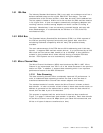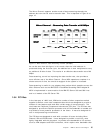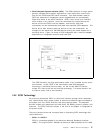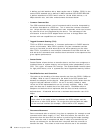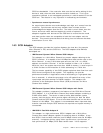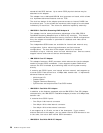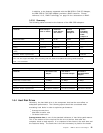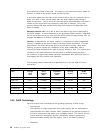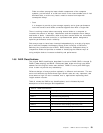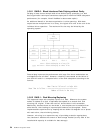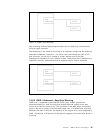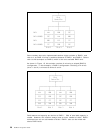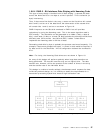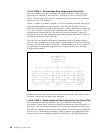
In addition to the features supported with the IBM SCSI-2 F/W PCI Adapter,
the IBM SCSI-2 F/W RAID adapter provides a RAID controller. Please
reference 1.6.5, “RAID Technology” on page 22 for a discussion on RAID.
1.6.3.1 Summary
The following tables summarize the features of the IBM SCSI adapters.
Table 3. SCSI Adapters Summary
Attribute SCSI Adapter
with no Cache
Enhanced
SCSI Adapter
with Cache
SCSI-2
Fast/Wide
Adapter/A
SCSI-2
Fast/Wide
Streaming
RAID
Adapter/A
SCSI Bus Width 16-bit 32-bit 32-bit 32-bit
SCSI Data Transfer Rate 5 MBps 5 MBps 20 MBps 20 MBps
Micro Channel Data Transfer Rate 8.3 MBps 16.6 MBps 20 MBps 40/80 MBps
Parity Optional Optional Yes Yes
Tagged Command Queueing
(TCQ)
N/A N/A Yes Yes
Systems where implemented 500 500/720
Note: Fast and Wide are data transfer methods as defined in SCSI-II.
The 720 will support 80 MBps data streaming with the SCSI-2 Fast/Wide Streaming RAID Adapter/A
N/A = not available
Table 4. PCI SCSI Adapters Summary
Attribute PCI SCSI-2 Fast
Adapter
PCI SCSI-2
Fast/Wide Adapter
PCI SCSI-2
Fast/Wide RAID
Adapter
SCSI Bus Width 32-bit 32-bit 32-bit
SCSI Data Transfer Rate 10 MBps 20 MBps 20 MBps
Parity Yes Yes Yes
Tagged Command Queueing (TCQ) Yes Yes Yes
Systems where implemented PC Server 300/310 PC Server 320/520 PC Server 320/520
Note: Fast and Wide are data transfer methods as defined in SCSI-II
1.6.4 Hard Disk Drives
Ultimately, the hard disk drive is the component that has the most effect on
subsystem performance. The following specs should be considered when
evaluating hard disks in order to optimize performance:
•
Average access time
•
Maximum transfer rate
•
On-board cache size
Average access time is one of the standard indicators of hard drive performance.
This is the amount of time required for the drive to deliver data after the
computer sends a read request. It is composed of two factors, the seek time and
the rotational delay. The seek time is the time necessary to position the heads
Chapter 1. IBM PC Server Technologies 21



